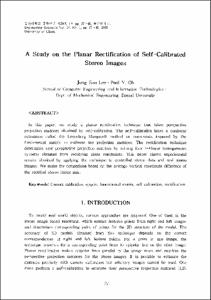對話의 인접짝에 관한 硏究0
- Alternative Title
- A Study on Adjacency Pairs of Conversation
- Abstract
- 對話分析은 一貫性있는 談話의 생성을 위한 規則을 발견하고 그러한 규칙에 의해 생성되는 각종 對話構造의 규명 기술을 그 目的으로 한다. 그런데 대화구조에는 화자의 交代를 組織化하고 한번에 한 사람이 이야기 것을 주로 意圖하는 말교대하기 체계를 기본으로 하여, 이러한 基本體系를 作動시켜 대화의 進行을 촉진시키는 가장 훌륭한 체계로 인접짝이란 連續體가 또한 存在한다.
本考에서는 우선 인접짝의 특성과 그 기능을 살피고, 다음으로 인접짝 후속부에 選好組織의 개념을 도입하여 그 구조적 특성을 검토하며, 동시에 질의(Q)-응답(A) 과 평가(A)-동의(A)/비동의(D)의 후속부에 대한 분석을 통하여 이의 體系化가능 유무를 考察하면서, 끝으로 硏究過程에서 파생된 問題點과 그 解決方案 등을 주로 살펴보려 했다.
그 主要 硏究結果를 간단히 요약하면, ⅰ) 인접짝의 規模는 삽입연속체나 과정/협의進展部 등의 내포를 통해 그 확대가 가능하며, 이 경우 話題不良에 따른 대화의 병리현상을 막기 위해 그 내용의 일관성이 유지되어야 함을 볼 수 있었고, ⅱ) 현행말차례는 선행말차례에 의해 影響을 받고 후속말차례에 영향을 끼침이 일반적이나, 역으로 그 後續部에 영향을 받을 수도 있으며, 뿐만아니라 인접짝을 포함하고 있는 全體組織에 의해서도 영향을 받을 수도 있었으며, ⅲ) 인접짝 Q-A와A-A/D의 분석을 통해 비록 複雜多糧한 樣相을 보이지만 그 後續部에 대한 體系化가 가능함을 볼 수 있었고, ⅳ) 인접짝은 통상 두 개의 말차례로 이루어져 나름의 獨自的인 連續體를 구성함이 일반적이나, 세개의 말차례로 된 연속체 등에도 變異形으로 처리될 수 있는 인접짝이 存在가능했다. 또한 對話時 그 位置에 拘碍받지 않고 출현 가능한 路部와 應急部 등의 존재로 인접짝의 또 다른 變異形을 예견할 수 있었다.
One of the major aims of Conversational Analysis is to discover the rules for the production of coherent discourse and to describe the conversational structures they generate. Among these structure are included not only 'a turn-taking system' designed to organize the change of speakers and keep only one speaker at a time, but also included 'adjacency pairs' to be deeply inter-related with the turn-taking system and to crank up and get rolling the system for furthering conversational interaction.
In this paper my main concerns are largely focused on the following issues: i) on the characteristics of adjacency pairs(=AP) and their fundamental functions, ⅱ) on the structural natures of 'preference organization for AP's second-parts analysis,ⅲ) on the possibility of systemization of the sophisticated second-parts by analyzing APs'Q-A' and 'A-A/D',ⅳ) on the problems prompted by this study and their solutions alike.
The key results thus obtained could be summarized as follows: 1. The size of AP may be expanded due to the existence of insertion sequence or processing/conference passes, in which case the maintenance of its coherent contents is essential to shun the pathological phenomena of conversation stemming from inpertinent topic shift. 2 A current turn, in constraining the design of the next turn, can be affected by the prior turn. However, more noticeable, it can be subject to both the influence of the next turn and that of the overall organization embedding AP. 3. Though the second-parts usually show complex aspects in their representations, their systemization may be found to be quite within the bounds of possibility by the partial analysis of APs 'Q-A' and 'A-A/D'. 4. AP is usually composed of two turn to be of its own status in conversation. The are, however, found as embedded. In addition to the embedded AP variants, there may be more chances for another kind of AP variants because there exist channel-clearing passes and emergency ones which can occur without any sort of positional constraints.
One of the major aims of Conversational Analysis is to discover the rules for the production of coherent discourse and to describe the conversational structures they generate. Among these structure are included not only 'a turn-taking system' designed to organize the change of speakers and keep only one speaker at a time, but also included 'adjacency pairs' to be deeply inter-related with the turn-taking system and to crank up and get rolling the system for furthering conversational interaction.
In this paper my main concerns are largely focused on the following issues: i) on the characteristics of adjacency pairs(=AP) and their fundamental functions, ⅱ) on the structural natures of 'preference organization for AP's second-parts analysis,ⅲ) on the possibility of systemization of the sophisticated second-parts by analyzing APs'Q-A' and 'A-A/D',ⅳ) on the problems prompted by this study and their solutions alike.
The key results thus obtained could be summarized as follows: 1. The size of AP may be expanded due to the existence of insertion sequence or processing/conference passes, in which case the maintenance of its coherent contents is essential to shun the pathological phenomena of conversation stemming from inpertinent topic shift. 2 A current turn, in constraining the design of the next turn, can be affected by the prior turn. However, more noticeable, it can be subject to both the influence of the next turn and that of the overall organization embedding AP. 3. Though the second-parts usually show complex aspects in their representations, their systemization may be found to be quite within the bounds of possibility by the partial analysis of APs 'Q-A' and 'A-A/D'. 4. AP is usually composed of two turn to be of its own status in conversation. The are, however, found as embedded. In addition to the embedded AP variants, there may be more chances for another kind of AP variants because there exist channel-clearing passes and emergency ones which can occur without any sort of positional constraints.
- Issued Date
- 1988
- Type
- Research Laboratory
- Alternative Author(s)
- Koo,Ja-Eun
- Publisher
- 연구논문집
- Language
- kor
- Rights
- 울산대학교 저작물은 저작권에 의해 보호받습니다.
- Citation Volume
- 19
- Citation Number
- 1
- Citation Start Page
- 19
- Citation End Page
- 41
- Appears in Collections:
- Research Laboratory > University of Ulsan Report
- 파일 목록
-
-
Download
 000002025219.pdf
기타 데이터 / 381.81 kB / Adobe PDF
000002025219.pdf
기타 데이터 / 381.81 kB / Adobe PDF
-
Items in Repository are protected by copyright, with all rights reserved, unless otherwise indicated.